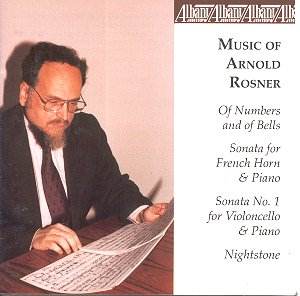Arnold ROSNER (1945-)
Of Numbers and of Bells (1983)
Horn Sonata (1979)
Cello Sonata No. 1 (1968 rev 1977)
Nightstone - Three Setting from The Song of Songs (1979)
 Timothy Hester and Nancy Weems
(pianos)
Timothy Hester and Nancy Weems
(pianos)
Heidi Garson (horn); Yolanda Liepa (piano)
Maxine Neuman (cello); Joan Stein (piano)
Randolph Lacy (ten); Timothy Hester (piano)
 ALBANY TROY 163
[67.13]
ALBANY TROY 163
[67.13]
AmazonUS

More Rosner, I am pleased to say.
Rosner is an American composer who has written extensively and has had his
works performed in the USA, Europe and Israel. He avoids atonalism and instead
treads a modal ethnic path redolent of Hovhaness and Bloch with greater
simplicity than the former and greater lyrical address than the latter.
Of Numbers And Of Bells: This is for two pianos which scatter
a gentle clean rain of notes. Liquidly running figures touched with bell
tones dance and toll in every range from high soprano to the most profundo
of bassos. Think in terms of Debussy's Cloches, of the bell-resounding
splendour of the Rachmaninov Etudes-Tableaux, of John Foulds' Essays
in the Modes and of the early Alan Hovhaness. Simplicity is Rosner's
'touchstone' but not simple-mindedness. Brave the composer who will hold
his invention up to the light without shade or the overlay of complexity
and harmonic density. Rosner is such a composer.
The Horn Sonata is remarkable for the degree to which two such different
instruments are integrated. This also speaks of the soloists' dedication
in a performance that is no run-through and which is very sensitive to dynamic
controls. The horn part strains at the bounds of technique without being
a circus act. I thought of the high natural harmonics on display in Britten's
Serenade. A quick central allegro is supported by two slower
movements. The liquid clarity of the Of Numbers and of Bells is to
be heard in the piano part. The outer lento and andante are
less concerned with the endless piano dance and more with the horn as singer.
The song is coloured and textured by middle-eastern modality. Rosner is
frequently bracketed with Hovhaness but he is less elaborate than Hovhaness.
In both the Horn Sonata and the Cello Sonata there are three movements
which adopt the slow-fast-slow pattern which also typefies the Delius and
Moeran violin concertos. The cello work has that dignified dip and turn of
phrase which I associate with the prayerful rhapsodies of Ernest Bloch but
with a more candid approach to singing themes. The soloist seems troubled
by unwelcome visions and sings as if to ward them off in melancholy desperation
as well as in celebration. The solo piano line (as so often with Rosner)
is touched with the echoes and decay of bell tones - think also in terms
of the tranced bell sounds from Vaughan Williams' On Wenlock Edge with
its shimmeringly portrayed 'coloured counties'. The clangorous central fuga
barbaro is less interesting than its partners and it comes as no surprise
that it has been extensively revised with its neighbours left intact. The
level of inspiration seems to flicker and fade here in a way that is absent
from the hymnals and prayers of the adagio and moderato. I wonder whether
what Rosner secretly wanted to do was to write three slow toned contemplative
movements. This is a fine work to be counted with the horn sonata but it
might well have convinced with ineluctable force if the central movement
had been of a piece with its companions.
The sound of the two sonatas is understandably a shade cloudier than the
two piano work and the song sequence. The piano role has that modal sound
we now recognise as Rosner's with its blend of Hovhaness, Bach and bells.
In Nightstone Ralph Lacy is healthy and steady of voice (listen
to the way he sustains the word figs at 2.58 in track 8). The words
are not provided in the booklet but you can hear every one of them. RVW's
voice returns in echo in the sung words 'with me from Lebanon' paralleling
VW's 'From Far from Even and Morning'. The Serenade has a typically
bell-dancing piano line around which the tenor weaves his erotic word painting.
I suspect that a major work based on The Song Of Songs is lurking
known or subliminal in Rosner's conscious or unconscious. I hope that it
emerges fully flowered for, going by this evidence, it will be a major addition
to the repertoire.
The two sonatas are analogue originals first issued on an Opus One Records
LP. Of Numbers and Nightstone are fully DDD.
Rob Barnett

